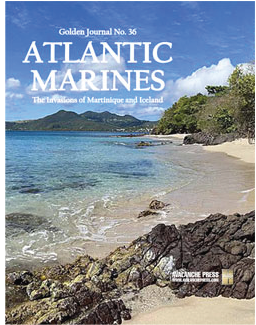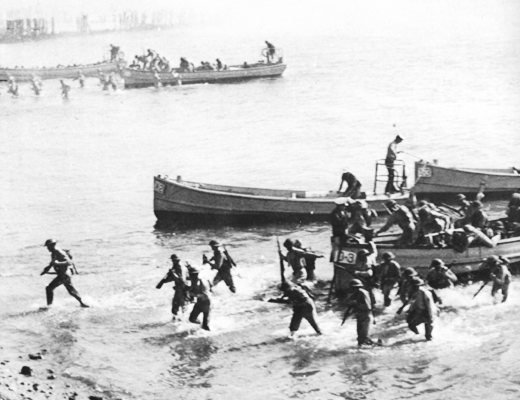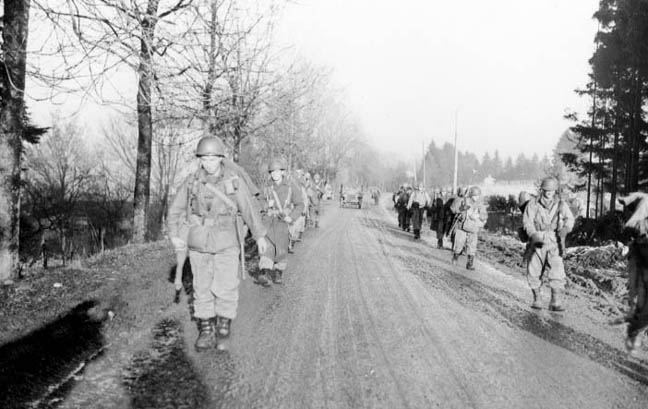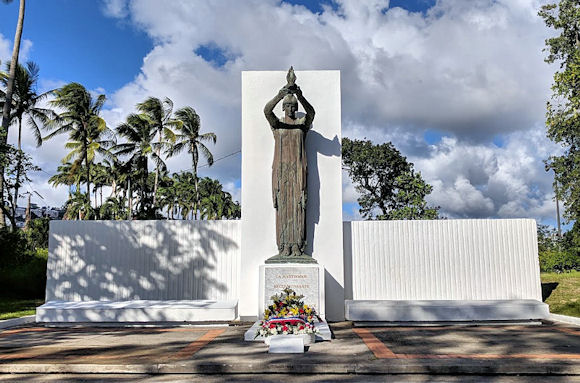| Golden Journal No. 36
(Atlantic Marines):
Martinique, Part Two
by Mike Bennighof, Ph.D.
February 2021
 Between 1940 and 1943 the United States prepared multiple versions of Operation Bungalow, the invasion of Martinique. The initial 1940 plan would have put the burden of the attack on the Atlantic Fleet’s brigade of U.S. Marines, to be followed up by the U.S. Army’s 1st Infantry Division. Between 1940 and 1943 the United States prepared multiple versions of Operation Bungalow, the invasion of Martinique. The initial 1940 plan would have put the burden of the attack on the Atlantic Fleet’s brigade of U.S. Marines, to be followed up by the U.S. Army’s 1st Infantry Division.
On 3 November 1940 the French military governor of Martinique, Admiral Georges Robert, signed off on what was described as a “gentlemen’s agreement” with the Americans. He would only move the warships at Martinique for maintenance purposes, and only after giving the Americans two days’ notice. One small warship could move freely to maintain communications with other French colonies in the Caribbean. In addition, Robert would not allow the aircraft or the gold brought to Martinique by the warships to be moved and he would notify the Americans if the Vichy government planned to replace him. In exchange, the Americans promised not to interfere with shipments of food and fuel to Martinique or the other French colonies.
Planning for an American invasion began while Rear Admiral John Greenslade - officially touring the Caribbean to select sites for American bases in the “bases-for-destroyers” deal with the British - was still conducting negotiations with Robert. In the last week of October President Franklin Roosevelt asked the Navy for a plan to occupy Martinique that could be executed on three days’ notice.

Marines practice for the Martinique landing. The Higgins boat had not yet been adopted, and the landings would have been made from Navy-supplied boats.
The Navy plan called for an amphibious assault by the 2,800 Marines of Brig. Gen. “Howling Mad” Smith’s 1st Marine Brigade, which had just shifted from Quantico, Virginia to Guantanamo Bay, Cuba. The brigade included the three rifle battalions of the 5th Marine Regiment, the 1st Battalion of the 10th Marine Regiment (an artillery unit), the 1st Marine Engineer Battalion, a light tank company and service and support units. They would be supported by a strong fleet built around two battleships, two aircraft carriers, four cruisers and sixteen destroyers. The Navy’s planners estimated that the French could field seven or eight thousand men, including armed sailors from the warships stranded in Fort-de-France, and that they would offer only token resistance. The landings would concentrate on the capital, chief port and naval base at Fort-de-France, seeking to secure the ships and the airfield and the 106 or 107 modern American-made fighter planes known to be present on the island but thought to be without pilots and probably not even assembled.
Since the Marines would not be enough to discourage resistance to the occupation, the Navy asked the U.S. Army to provide the 1st Infantry Division as a follow-up force. The Army’s War Plans Division had a very different view of the proposal than their Navy counterparts. The Vichy French garrison of Dakar in Senegal had fought back resolutely against a British and Free French attack in September 1940 and driven off the invaders. The Army’s planners saw no reason to assume that the Martinique garrison would show any less will to fight.
Against 8,000 determined defenders, the Army planners believed the invading force would need at least 25,000 well-trained and thoroughly equipped troops, whether Army or Marine. Chief of staff George C. Marshall directed that any move against Martinique would have to be conducted with overwhelming force, to minimize both American and French casualties.
The United States simply did not have 25,000 men for such an operation in the last weeks of 1940. The 1st Infantry Division, said to be the best-trained division in the U.S. Army, had just adopted a new table of organization on 1 November that boosted its strength from slightly more than 9,000 men to over 15,000. Few of those six thousand new troops had yet arrived at the division’s home station at Fort Hamilton in Brooklyn, and when they did, they would have had very little training. Maj. Gen. Walter Short’s staff sketched out a plan to quickly re-organize the division into three task forces built around the division’s three regimental headquarters. Only one of them, of 5,000 men, was considered capable of fighting in actual combat. Another, also of 5,000 men, could be entrusted with occupying the nearby island of Guadeloupe which had very few French troops. The remaining task force of essentially untrained new men could not be deployed in a combat zone in any capacity.
The War Plans Division instead recommended occupying European possessions in the Caribbean other than Martinique, and sending the 1st Infantry Division to Puerto Rico for intensive amphibious assault training. How the U.S. Army would occupy these additional islands without 1st Infantry Division troops was not explained.
Marshall and Secretary of War Henry Stimson had even deeper misgivings than the War Plans Division. An act of aggression while the United States remained formally of peace would go over very poorly in word opinion, and an attack on yet another French colony might drive the French command in North Africa to openly side with the Axis. Even worse, an attack by no more than 8,000 men against a garrison of similar size could easily result in a disastrous defeat.
That conclusion shelved Operation Bungalow, and a month later the new American ambassador to Vichy France, Admiral William Leahy, received assurances from Vichy chief of state Philippe Pétain that his rump state would not collaborate directly with the Axis, and that the French fleet would be scuttled before it fell into Nazi hands. Leahy, at Roosevelt’s direction, replied that as along as those guarantees remained in place and French territory and resources were not used against American interests, the United States would maintain the status quo in the Caribbean.

The Get Off Your Ass Battalion marches to its doom, December 1944.
The planning for Operation Bungalow did reveal serious flaws in American capabilities; first and foremost, that the United States had no capability to project power with ground forces. New directives exempted 1st Infantry Division and the 3rd Infantry Division from providing cadres for new units. They would train intensively for amphibious operations and receive priority for new weapons and equipment. The United States would not be caught again without the ability to mount an expeditionary force on short notice.
Martinique was not forgotten, however, particularly after a German submarine landed a wounded crewman there and the Americans suspected the French of providing far more than medical aid. In April 1941 reports said German pilots had arrived to fly converted commercial airliners in an attack on the Panama Canal. And so in July 1941 the Army established the 550th Air Landing Battalion (later the 550th Glider Battalion) at Fort Kobbe in the Panama Canal Zone and moved the 501st Parachute Infantry Battalion there as well. The existence of both units, and their presence in Panama, was classified Top Secret, and the men trained and prepared for an invasion of Martinique with a secondary mission of intervention elsewhere in Latin America.
In November 1942 the 501st left for Australia, leaving behind one company to form a cadre for the new 551st “Get Off Your Ass” Parachute Infantry Battalion. The 551st would jump onto the airfield at Fort-de-France, secure the runway, and then the 550th would join them there, quickly alighting from C-47 transports. Meanwhile the ground element - the independent 33rd 1st Infantry Regiment, usually part of the Canal Zone garrison - would come over the beaches and join the airborne forces in securing the capital.
After the Allied invasion of French North Africa, the Americans stepped up the pressure on Robert’s regime. The French admiral ruled the island like an uncrowned monarch, and his arrogance made him little loved by the people. In November 1942 the Americans and British instituted an embargo of food and fuel shipments to Martinique and the other French colonies. American destroyers now steamed offshore every night, and PBY Catalina flying boats flew over Fort-de-France daily. In March 1943 the 33rd Infantry moved to Fort Reade in British-ruled Trinidad and began practicing amphibious landings. French Guiana on the South American mainland expelled its Vichy governor in March, and riots against Vichy broke out on Guadeloupe in April.

Martinique remembers. The Great War memorial of Fort-de-France.
Before the Americans could strike, unrest broke out on Martinique. On 24 June, civilian demonstrators rallied in front of Fort-de-France’s monument to Martiniqais fallen in the Great War. Three days later the commander of the garrison’s troops, Commandant Henri Tourtet, led them in a mutiny against Robert’s command, seizing Fort Desaix overlooking the harbor of Fort-de-France and proclaiming by radio that the garrison had rallied to the Free French cause. Tourtet had been exiled to Martinique specifically because of his Gaullist sympathies, which probably was not the best decision of the Vichy government. Robert resigned and handed over power to Henri Hoppenot , the Washington representative of the French National Liberation Committee, and went into exile in the United States, eventually making his way back to Vichy France.
Martinique had been liberated without a fight. Tourtet organized a battalion of volunteers to join the Free French forces in North Africa. The two American airborne battalions would see some action as independent units in Europe before both were essentially wiped out in the Battle of the Bulge.
You can carry out that invasion in Golden Journal No. 36: Atlantic Marines.
Click here to join the Gold Club.
See your Gold Club Insider newsletter for ordering information.
Sign up for our newsletter right here. Your info will never be sold or transferred; we'll just use it to update you on new games and new offers.
Mike Bennighof is president of Avalanche Press and holds a doctorate in history from Emory University. A Fulbright Scholar and NASA Journalist in Space finalist, he has published zillions of books, games and articles on historical subjects.
He lives in Birmingham, Alabama with his wife, three children, and his dog Leopold, who is a good dog.
Want to keep Daily Content free of third-party ads? You can send us some love (and cash) through this link right here.
|
